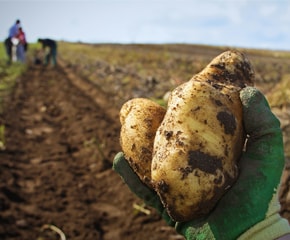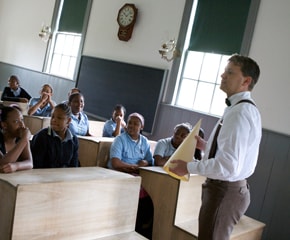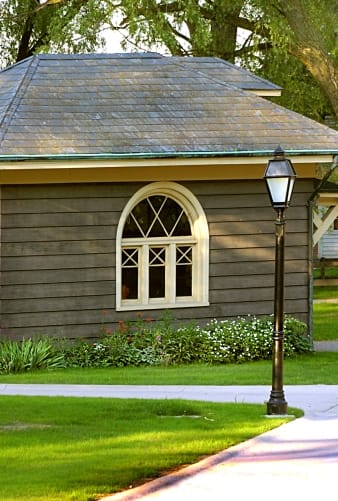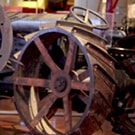What If
From flowers to fruits, grasses to grains, Luther Burbank introduced more than 800 plant varieties to American agriculture. But his first great plant invention—a blight-resistant potato—remains his most enduring contribution to the world. There is nothing magical or mysterious about my methods, and what I learned to do others can learn to do. Luther Burbank
Gardener of Invention
Like many New England farmers in the late 1800s, Luther Burbank grew potatoes. Then as now, the potato was one of the world’s most important food crops. Easily cultivated in a variety of climates and a cheap source of calories, it has long been praised for both its nutritional and economic benefits.
Henry Ford and Luther Burbank, circa 1915
Artifact
Photographic print
Summary
Henry Ford admired the work of Luther Burbank (1849-1926), an American plant breeder, naturalist, and author who was especially noted for his experiments with plants, fruits, and vegetables. The fellow innovators posed together for this photograph around 1915.
Keywords
Object ID
P.188.2979
Credit
From the Collections of The Henry Ford. Gift of Ford Motor Company.
Location
By Request in the Benson Ford Research Center
Get more details in Digital Collections at:
Henry Ford and Luther Burbank, circa 1915
What is The Henry Ford?
The national attraction for discovering your ingenuity while exploring America’s spirit of innovation. There is always much to see and do at The Henry Ford.
One late-summer afternoon in 1872, when Burbank was 23, he spotted a tiny green seed ball among a crop of Early Rose potatoes. Dangling from the leafy plant, it resembled an unripe cherry tomato. Another farmer might’ve dismissed it as an undesirable growth, since most everyone grew potatoes not from seeds but by subdividing and planting the bulbs or tubers.
But Burbank wasn’t like other farmers. Aside from his desire to produce a healthy harvest to sell at the local market, he was also fascinated by evolutionary processes. His interest was sparked by reading Charles Darwin’s theory of heredity in his 1868 book The Variation of Animals and Plants under Domestication, published when Burbank was 19.
It was one of the most important books Burbank ever discovered at his local library, where he went to read and teach himself horticulture and botany. Unlike many of his high school peers, Burbank didn’t pursue a college degree but instead purchased 17 acres near Lancaster, Massachusetts, where he was raised. He grew up on a farm and had a distant relative, W. Atlee Burpee, who was a seed magnate. When Burbank got his own farm, he immediately began experimenting with cross-fertilizing plants, including beets and beans.
When he discovered the rare potato seed ball he “remembered his reading of Darwin and the master’s insistence that a single plant could contain multiple variations,” Jane S. Smith wrote in her 2009 biography of Burbank. “Vegetal reproductions hid those differences, but an enterprising experimenter could perhaps uncover them. It would be his first exercise in assisting evolution.”
Burbank let the seed pod ripen. When he finally opened it, he was delighted to find 23 seeds inside. He planted them the following spring and waited to see what ancestral secrets they might reveal. All the seeds produced potatoes. But only one seed produced bigger, better potatoes. The following season, Burbank took these potatoes, subdivided the tubers and planted them. The resulting harvest confirmed he had indeed discovered a new and improved potato variety, bigger and firmer with a pleasing russet-colored skin. The flesh was whiter and less blemished with eyes than Burbank had ever seen. It was tastier too.
With consistent results during subsequent plantings, Burbank and the rest of the world soon discovered that this new variety—named the Russet Burbank potato—promised four times the yield of traditional potatoes. It was also faster-growing and more resistant to disease. Born in 1849, Burbank was an infant at the end of the Irish Potato Famine. He was aware of the catastrophic suffering that could be caused by a failed crop. He also knew a blight-resistant potato could change the world.
Propagating New Possibilities
The Russet Burbank potato’s influence was so great that even more than a century later it remains one of the world’s most popular varieties. Now commonly known as the Idaho potato, it is used in everything from popular supermarket potato chips to McDonald’s French fries.
Several years after his famous discovery, Burbank decided to pursue his horticulturist dreams in California. He sold the rights to his potato seeds for $150, a large sum at the time, and moved north of San Francisco, to Santa Rosa. He bought land and devoted himself to plant experiments and exploring precisely how traits in plants are passed from generation to generation. He wanted to understand what made certain characteristics visible in plants and what made those same traits hidden. “A knowledge of the battle of the tendencies within a plant,” he once wrote, “is the very basis of all plant improvement.”
During his long career, Burbank introduced over 800 new plants, including flowers, grains, grasses, vegetables, cacti, and more than 200 varieties of fruit alone; these included a thornless blackberry, a stoneless plum, and a plum-apricot hybrid known as a “plumcot.” “Burbank’s prolificacy grew out of a creativity that could seem almost shameless,” observed one journalist in a 2015 New Yorker article, which called attention to Burbank’s diminished fame in modern times despite the relevancy of his ideas in today’s world of food modification. “He was willing to cross just about anything that had leaves.”
Burbank gained admirers around the world for his extraordinary contributions to agriculture. Most famously, he developed close friendships with Henry Ford and Thomas Edison. Ford and Edison frequently made the long trip west to visit Burbank in his Santa Rosa office, which overlooked his 40-acre experimental garden.
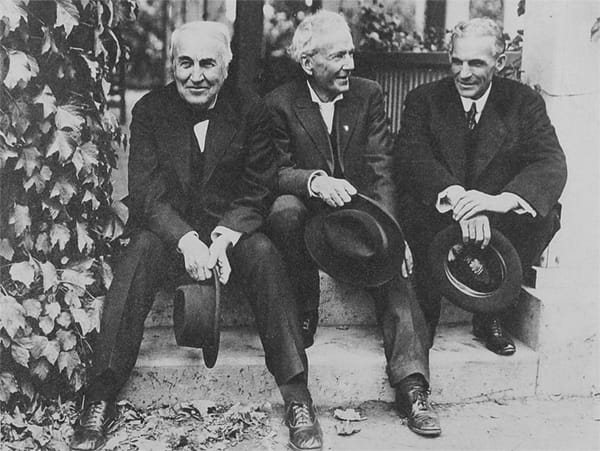
Cornerstone of Edison Institute Signed by Thomas A. Edison, September 27, 1928
Artifact
Cornerstone
Date Made
1928
Summary
The cornerstone commemorates the dedication of The Henry Ford. It suggests a union of nature (Luther Burbank's spade) and technology (Edison's signature and footprints). That unity is borne out by the block itself, made from Portland cement refined from blast furnace slag at the Ford's Rouge plant--a great example of Henry Ford approaching industry like a good farmer, denying the concept of waste.
Place of Creation
Object ID
28.376.1
Credit
From the Collections of The Henry Ford.
Get more details in Digital Collections at:
Cornerstone of Edison Institute Signed by Thomas A. Edison, September 27, 1928
What is The Henry Ford?
The national attraction for discovering your ingenuity while exploring America’s spirit of innovation. There is always much to see and do at The Henry Ford.
Burbank’s towering significance to Henry Ford can be seen in the cement block that commemorates the dedication of The Henry Ford. That event took place in September 1928, two and a half years after Burbank had passed away at the age of 77. And yet Burbank was still a celebrated presence at the dedication ceremony.
At that event, 81-year-old Edison walked carefully across the wet cement and signed his name. Then he thrust a spade of Burbank’s into the slab. The Cornerstone, which remains prominently on display in Henry Ford Museum today, represented Henry Ford’s vision of the union of agriculture and industry for the betterment of humanity.
Cultivating Innovator Traits
Survey the essays and biographies of Burbank’s prolific career and the tributes are quick to praise his quietly steadfast nature, his discipline, patience, and powers of observation. Some considered his talents so extraordinary they verged on the mystical. This perception gave rise to his nickname, “The Plant Wizard.”
And yet listen to Burbank recall his youth, as he did during a rare interview with The New York Times in 1906, and you’ll discover he does not believe he was born with the traits essential to his success as a legendary agricultural innovator. By his account, he was himself an example of improvements that could be deliberately pursued, not through successive generations (Burbank never had any children of his own), but through a kind of “selection” experiment played out during the span of an individual life.
In the story Burbank told The Times, he visited a doctor when he was a boy. The doctor declared him unfocused and undisciplined—in today’s medical language, this might have amounted to a diagnosis of attention deficit disorder, or worse. Burbank agreed with the assessment. “I saw that I had a way of beginning fifty tasks and ending none,” he said. “I began the most rigid course of self-discipline.”
I saw that I had a way of beginning fifty tasks and ending none. I began the most rigid course of self-discipline.
 Luther Burbank
American Botanist and Horticulturist
Luther Burbank
American Botanist and Horticulturist
Oil Painting, "Mr. Luther Burbank in His Garden Office" by Irving R. Bacon, 1945
Artifact
Painting (Visual work)
Date Made
1945
Summary
This painting depicts Luther Burbank, a horticulturalist known for inventing more than 800 plants. Irving Bacon, Henry Ford's favorite artist, apparently based this portrait of Burbank at work in his office on a photograph that Burbank's widow shared with Ford in 1928.
Place of Creation
Keywords
Object ID
00.28.32
Credit
From the Collections of The Henry Ford.
Location
Not on exhibit to the public.
Related Objects
Get more details in Digital Collections at:
Oil Painting, "Mr. Luther Burbank in His Garden Office" by Irving R. Bacon, 1945
What is The Henry Ford?
The national attraction for discovering your ingenuity while exploring America’s spirit of innovation. There is always much to see and do at The Henry Ford.
Years later as a young man, his cultivation of focus and attentiveness surely contributed to his discovery of the rare potato seeds. In that same interview, Burbank was asked what he considered his greatest contributions to the world of plant development. “I have said before that it was a well-meant but inaccurate thought that gave me the name of ‘The Plant Wizard,’” he answered. “I have a gift or a special ability or what folks call a genius for selection, but there is nothing magical or mysterious about my methods, and what I learned to do, others can learn to do, and what I have started, others can finish, and what I have found out about the laws of nature in this connection can be applied by others and added to by others, if only they will waken to the possibilities that exist.”
Browse Collections
Luther Burbank Birthplace
Artifact
House
Date Made
circa 1820
Summary
Luther Burbank (1849-1926), an American plant breeder, naturalist, and author, was especially noted for his experiments with plants, fruits, and vegetables. He was born in this house, built around 1800 and originally located in Lancaster, Massachusetts. Although he attended local schools there, much of his knowledge about nature and plant life came from reading books at the public library.
Place of Creation
Object ID
36.811.1
Credit
From the Collections of The Henry Ford.
Get more details in Digital Collections at:
Luther Burbank Birthplace
What is The Henry Ford?
The national attraction for discovering your ingenuity while exploring America’s spirit of innovation. There is always much to see and do at The Henry Ford.
Luther Burbank Garden Office
Artifact
Office building
Date Made
1909
Summary
Luther Burbank (1849-1926), an American horticulturalist and author, gained a reputation for selective breeding that yielded more than 800 new fruits, vegetables, flowers, and other plants. He opened this Bureau of Information in 1910 at the corner of his 40-acre experimental garden in Santa Rosa to sell seeds and souvenirs. It served various purposes over the years until Burbank's widow offered it to Henry Ford in 1928.
Place of Creation
Object ID
28.1002.1
Credit
From the Collections of The Henry Ford.
Get more details in Digital Collections at:
Luther Burbank Garden Office
What is The Henry Ford?
The national attraction for discovering your ingenuity while exploring America’s spirit of innovation. There is always much to see and do at The Henry Ford.
Luther Burbank Garden Office, Original Site, Santa Rosa, California, circa 1910
Artifact
Photographic postcard
Summary
Luther Burbank (1849-1926), an American horticulturalist and author, gained a reputation for selective breeding that yielded more than 800 new fruits, vegetables, flowers, and other plants. He opened this Bureau of Information in 1910 at the corner of his 40-acre experimental garden in Santa Rosa to sell seeds and souvenirs. After 1913, the building had various uses until Burbank's widow offered it to Henry Ford in 1928.
Creators
Object ID
2008.0.1.4
Credit
From the Collections of The Henry Ford.
On Exhibit
Not on exhibit to the public.
Get more details in Digital Collections at:
Luther Burbank Garden Office, Original Site, Santa Rosa, California, circa 1910
What is The Henry Ford?
The national attraction for discovering your ingenuity while exploring America’s spirit of innovation. There is always much to see and do at The Henry Ford.

Lithograph, "Plumcots, Samples of a Distinct New Species of Fruit Produced by Luther Burbank" 1909
 Details
Details
Lithograph, "Plumcots, Samples of a Distinct New Species of Fruit Produced by Luther Burbank" 1909
Artifact
Print (Visual work)
Date Made
1909
Place of Creation
Object ID
45.55.9.1
Credit
From the Collections of The Henry Ford. Gift of Mrs. Luther Burbank.
Location
Not on exhibit to the public.
Get more details in Digital Collections at:
Lithograph, "Plumcots, Samples of a Distinct New Species of Fruit Produced by Luther Burbank" 1909
What is The Henry Ford?
The national attraction for discovering your ingenuity while exploring America’s spirit of innovation. There is always much to see and do at The Henry Ford.
Lithograph, "The Leader, New Crawford x Muir Peach Produced by Luther Burbank" 1909
Artifact
Print (Visual work)
Date Made
1909
Place of Creation
Keywords
Object ID
45.55.4.1
Credit
From the Collections of The Henry Ford. Gift of Mrs. Luther Burbank.
Location
Not on exhibit to the public.
Get more details in Digital Collections at:
Lithograph, "The Leader, New Crawford x Muir Peach Produced by Luther Burbank" 1909
What is The Henry Ford?
The national attraction for discovering your ingenuity while exploring America’s spirit of innovation. There is always much to see and do at The Henry Ford.
Fordson Tractor, 1917-1918, Used by Luther Burbank
Artifact
Tractor (Agricultural equipment)
Date Made
1917-1918
Summary
The Fordson tractor, manufactured by Henry Ford and Son, Inc., was the first lightweight, mass-produced tractor that was affordable to the average farmer. Through this and other efforts, Henry Ford sought to relieve farmers of the burden of heavy labor. Ford gave this Fordson, the first production model, to fellow innovator Luther Burbank, creator of hundreds of new plant varieties.
Creators
Place of Creation
Object ID
00.136.291
Credit
From the Collections of The Henry Ford. Gift of Ford Motor Company.
Get more details in Digital Collections at:
Fordson Tractor, 1917-1918, Used by Luther Burbank
What is The Henry Ford?
The national attraction for discovering your ingenuity while exploring America’s spirit of innovation. There is always much to see and do at The Henry Ford.
Oil Painting, "Mr. Luther Burbank in His Garden Office" by Irving R. Bacon, 1945
Artifact
Painting (Visual work)
Date Made
1945
Summary
This painting depicts Luther Burbank, a horticulturalist known for inventing more than 800 plants. Irving Bacon, Henry Ford's favorite artist, apparently based this portrait of Burbank at work in his office on a photograph that Burbank's widow shared with Ford in 1928.
Place of Creation
Keywords
Object ID
00.28.32
Credit
From the Collections of The Henry Ford.
Location
Not on exhibit to the public.
Related Objects
Get more details in Digital Collections at:
Oil Painting, "Mr. Luther Burbank in His Garden Office" by Irving R. Bacon, 1945
What is The Henry Ford?
The national attraction for discovering your ingenuity while exploring America’s spirit of innovation. There is always much to see and do at The Henry Ford.
Henry Ford and Luther Burbank, circa 1915
Artifact
Photographic print
Summary
Henry Ford admired the work of Luther Burbank (1849-1926), an American plant breeder, naturalist, and author who was especially noted for his experiments with plants, fruits, and vegetables. The fellow innovators posed together for this photograph around 1915.
Keywords
Object ID
P.188.2979
Credit
From the Collections of The Henry Ford. Gift of Ford Motor Company.
Location
By Request in the Benson Ford Research Center
Get more details in Digital Collections at:
Henry Ford and Luther Burbank, circa 1915
What is The Henry Ford?
The national attraction for discovering your ingenuity while exploring America’s spirit of innovation. There is always much to see and do at The Henry Ford.
Cornerstone of Edison Institute Signed by Thomas A. Edison, September 27, 1928
Artifact
Cornerstone
Date Made
1928
Summary
The cornerstone commemorates the dedication of The Henry Ford. It suggests a union of nature (Luther Burbank's spade) and technology (Edison's signature and footprints). That unity is borne out by the block itself, made from Portland cement refined from blast furnace slag at the Ford's Rouge plant--a great example of Henry Ford approaching industry like a good farmer, denying the concept of waste.
Place of Creation
Object ID
28.376.1
Credit
From the Collections of The Henry Ford.
Get more details in Digital Collections at:
Cornerstone of Edison Institute Signed by Thomas A. Edison, September 27, 1928
What is The Henry Ford?
The national attraction for discovering your ingenuity while exploring America’s spirit of innovation. There is always much to see and do at The Henry Ford.

Discussion Questions
- What or who motivated Luther Burbank to innovate?
- What traits of an innovator did Luther Burbank illustrate?
- Which of these traits do you think was most important to his success inventing the Russet Burbank potato?
- Do you think you could solve food problems of today with some of the same approaches made famous by Luther Burbank? What food problem would you want to solve?
- Do you think you can be an innovator like Luther Burbank? Why or why not?
Fuel Your Enthusiasm
The Henry Ford aims to provide unique educational experiences based on authentic artifacts, stories and lives from America’s tradition of ingenuity, resourcefulness, and innovation. Connect to more great educational resources:








